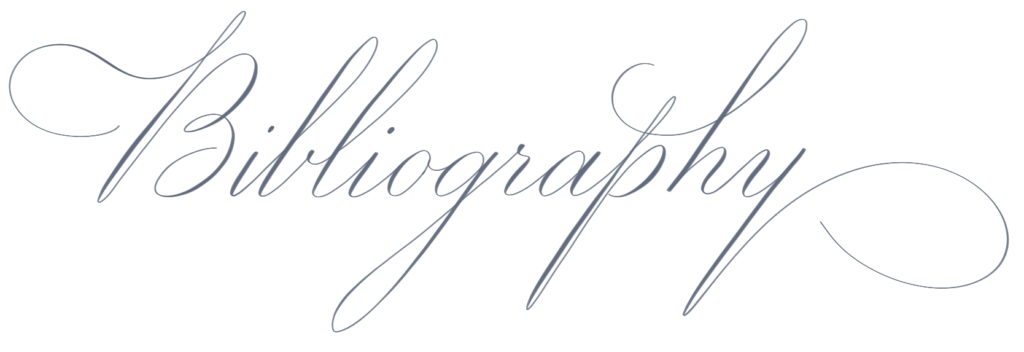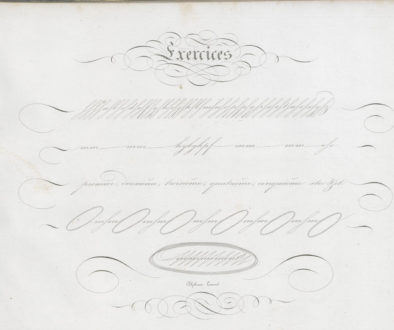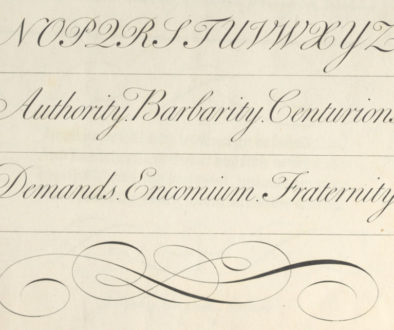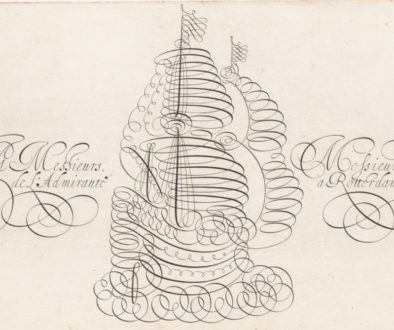The history of American penmanship starts with the publication of the very first 100 % American copybook : John Jenkins’s Art of writing, in 1791… Before this publication, European copybooks had been the only references used by writing teachers in the USA. Jenkins’s publication was different from most of the copybooks availaible, because it did not just offer pages of examples to copy : it promised to make “penmanship “plain and easy”, and therefore accessible to more people.
In the late 18th century, handwriting was a valued skill : it was essential for commerce, education, government as well as an important social tool. But unlike Europeans who still had to use specific hands for specific purposes (ladies used the italian hand, men used a round running hand, there was a style for government, and a style for commerce…), Americans only used one style – the round hand-, and they needed it to be both beautiful and practical. However, handwriting reflected social status : men who had an elegant, flourished hand were identified as gentlemen, and people who scribbled in a sloppy handwriting were not as “honorable”. Naturally, writing masters who could teach both elegant and practical styles with success were highly sought after.
Jenkins, who had stuggled with learning how to write the “old fashioned way”, devised a system in which each letter was constructed from a mixture of a few basic components. His students only had to learn a few strokes and principles instead of all the letters and their variations… which made it much easier and faster to get satisfactory results. This was not the first time that this method had been described, but the success of Jenkins’s book made it a popular new way to teach handwriting (and calligraphy).
Jenkins advocated simple elegance and practicality, his Art of Writing displayed a plain round hand, stripped of any useless decorative strokes but gave much importance to proportion, slant and spacing. However, Jenkins’s method did not care for speed, to the contrary, slowing down was the best way to obtain the almost mathematical perfection of form that was desired… These theories were echoed in other copybooks during the first half of the 19th century, they are at the roots of the Engrosser’s script that is still used today.
Of course, not everyone agreed with this slow but deliberate approach to penmanship. In 1830, Benjamin Foster offered an alternative with his Practical Penmanship, inspired by Carstairs’s “muscular movement” system that had been so popular in Europe, and that proved to be much more useful for professional purposes. The system was taught in the many business colleges that opened thoughout the country.
A few years later, Platt Rogers Spencer successfully devised a “new” system that exploited both Jenkins’s analytical approach (seeking grace) and Carstairs’s movement oriented approach (seeking speed). His Spencerian Penmanship met a huge success and shaped the American cursive handwriting up until today. Business colleges quickly adopted this efficient, truly American hand, and the style eventually evolved into the more practical “business penmanship”. In schools too, Palmer’s plain penmanship based on spencerian principles eventually replaced the vertical round hand that had been popular until the turn of the 20th century.
Just like in Europe, both practical penmanship systems and ornamental calligraphic and lettering styles found a way to coexist. The development of everyday handwriting does not mean that artistic writing does not have a place : throughout the 19th century, decorative hands were still used for certificates, important documents and, mostly, for advertising. The best penmen, skilled in many different styles of plain and ornamental lettering, enjoyed exchanging specimens of their best works, showing off their creative and technical skills to their colleagues. From the 1960’s, the styles they used were inspired by the spencerian shapes and principles (ornamental penmanship), by older european writing styles (the English round hand became engrosser’s script, the French ronde, Gothic hands and the italian hand also evolved into the hands of American penmen) and by typography… All of these influences can be seen in books published around 1900, like the Zanerian Manual.
A lot of books were published during this period, and countless original specimens are still in collections today. I couldn’t list everything and chose to focus on the references that weren’t listed anywhere else and on the books that I find more important. I can only recommend that you check out the resources listed at the end of the page for even more inspiration and information on each of the American calligraphy styles.
Before American Penmanship : the English Round Hand
JENKINS (John), The Art of Writing reduced to plain and easy system, 1791. (Newberry, better quality)
The first “purely American” copybook, designed and produced in the USA… The first edition wasn’t much more than a small manual, but by 1813 when the second edition was published, Jenkins’ system had become the American handwriting standard. This system was popular because Jenkins broke down each letter into principal strokes that could be combined to form letters. Although he called it “New and Easy,” this practice was in fact centuries old. In his opinion, students didn’t have to strive for perfection in writing, but had to understand the underlying principles that would allow them to “engineer” their own handwriting. While other penmen were a bit disdainful of Jenkins, his book bore the “recommendation” of dozens of New England luminaries, including Benjamin Franklin and John Hancock.
HUNTINGTON (Eleazer), An introduction to the art of penmanship…, 1816.
This small copybook breaks down the round hand lowercases and provides models of capital letters. The style is kept very simple. The last section of the book is about stenography.
GOULD (Nathaniel Duren), Penmanship, or, The beauties of writing exemplified in a variety of specimens, practical and ornamental, 1822.
Gould was known for his works as a musician and writing teacher , and for his publications on penmanship. This volume contains plenty of examples of the english round hand and its variations.
BAZELEY (Charles W.), The elements of analytical and ornamental penmanship, 1830.
In this copybook, the round hand’s proportions are analysed in detail. The author also provides examples of running hand, lettering alphabets, german text.
FOSTER (Benjamin Franklin), Practical penmanship being a development of the Carstairian system, 1830.
Foster was a famous and prolific writer on penmanship and bookkeeping. In 1827, he founded the first private business school in America, where penmanship was part of the fundamental curriculum. This book was his first publication on handwriting. It exposes the ideas that Joseph Carstairs had published in 1814 and even reuses the illustration of Carstairs’ Lectures on the Art of writing. This method based on whole arm movement opened the door to the more efficient semi-angular systems that came later on through Dunton’s and Spencer’s works.
NOYES (Enoch), Noyes’s penmanship, 1839.
This small booklet contains all the basic instructions on how to execute the round hand, illustrations also include models of running hand and of lettering alphabets.
TOWNDROW (Thomas), Towndrow’s Complete system of penmanship, 1839.
A manual containing pages of repetitive exercices of lowercase letters. The end of the book shows examples of hand lettered (drawn) alphabets as well as round hand capitals.
FOSTER (Benjamin Franklin), Penmanship, theoretical and practical, illustrated and explained, 1843.
Another popular publication from Foster. This time, he breaks down the letters in the same way Jenkins did and gives explanations for a slower round hand.
BECKER (George J.), Becker’s ornamental penmanship, 1854.
Becker was a teacher of drawing, writing and bookkeeping. He also authored a series of copybooks demonstrating his own version of American running penmanship. The models in this book are generally meant to be drawn rather than written, but the examples of calligraphed hands are beautifully executed. This book contains one of the finest models of round hand capitals from the 19th century… A downloadable scan can be found here, the link above is “stream only”.
Movement writing, Spencerian and similar systems.
DOLBEAR (Thomas Pearce, Rufus, J.W., S.F. and Levi ), The Science of practical penmanship : or the analysis of taste and freedom, c.1836 (7th edition, from 1850).
Plates available here.
The Dolbear family’s book on penmanship was as popular as the Spencer family’s works would be a few decades later. This book focuses on a method built from Carstair’s principles and ideas, adapted with the authors’s own theories on the matter of muscular movement. The main book includes theories and descriptions of movement exercises and letters, all illustrations are in the book of plates, or “Chirographic Atlas“.
DUNTON (Alvin R.), The Original Duntonian System of Rapid Writing, 1843.
Dunton is probably the first to have published a model of truly American writing style… In penmanship, it is always hard to tell who came up with the idea of a new style first, it all comes down to how a few penmen’s work allowed a script to evolve into something new. Duntonian’s principles were very similar to Spencerian’s and both were a “natural” evolution of the movement writing that had been developed in Europe earlier in the century… Alvin Dunton was extremely skilled with the pen, and his hand was actually much more graceful than Spencer’s (in my opinion). This book came out 5 years before Spencer’s earliest publication and went through 13 editions. Dunton was quite successful, but Spencer’s sons marketing skills surpassed his own and Dunton’s name and method are not the ones History remembers the best (read more about this matter here). However, some aspects of Dunton’s style are recognisable in Spencer’s sons publications, it is probable that as both systems were very similar, they influenced one another and eventually became one. I couldn’t find Dunton’s first copybook online, but I thought his story deserved to be told as well… Samples of his work from 1859 can be seen here and here. Another of his copybooks is listed below (1877).
SPENCER (Platt R.), Compendium of Spencerian, or semi-angular penmanship, 1855.
Spencer had a writing school in Ohio that attracted students from many (western) states when he decided to publish his method. This copy is a revised publication of one of his first copybooks… It was actually published in 1866 as part of a 13 book series. His books and his teachings were popular, but real success came after his death in 1864, when his sons carried on his project and published the definitive collection of all of his teachings in the New Compendium of penmanship (1879).
LINTON (Oliver) & COMER (George), Penmanship made easy, 1864.
This book contains instructions and examples for a style still very close to European movement writing.
SPENCER (brothers), Spencerian key to practical penmanship, 1866.
You can see better images of an incomplete copy here.
PRATT (W.H.), Portrait of Lincoln made of calligraphy, 1867.
An historical example of portrait made of calligraphy…
DUNTON (Seldom), PAYSON & SCRIBNER, Payson, Dunton and Scribner’s national system of penmanship, 1870.
Seldom Dunton was Alvin’s brother. He had worked with his brother for a time, then associated himself with two of A.R. Dunton’s former students to publish their own copybooks on “Duntonian”. These publications were a big success.
DUNTON (Seldom), PAYSON & SCRIBNER, The Payson, Dunton and Scribner manual of penmanship, 1872.
SPENCER (brothers), Theory of Spencerian penmanship or schools and private learners, 1874.
High-res download.
GASKELL (George Arthur), Guide to writing, pen-flourishing : Gaskell’s complete compendium of elegant writing, 1875.
Gaskell studied penmanship under P.R. Spencer, his style was in fact more like his teacher’s than Spencer’s sons’s. He was the principal of the reputable Bryant & Stratton Business College (Manchester, New Hampshire), where he attracted many eminent penmen. Louis Madarasz, W.E. Dennis and A.N. Palmer are among the penmen on whom Gaskell’s publications and teachings had a big influence.
DUNTON (Alvin R.), Manual of free-hand penmanship, 1877.
This copybook from Spencer’s main competitor contains details of his own methods. One of the plates displays a beautiful example of shaded “Spencerian” (Duntonian, actually).
SPENCER (Lyman P.) & Spencerian authors, New Spencerian compendium of penmanship, 1879.
Full Hi-res scan download here.
One of the best resources on original Spencerian, put together by Spencer’s sons. In my opinion, their style was much more graceful than their father’s. Better scans of the capital variations here.
GASKELL (George Arthur), Gaskell’s compendium of forms, 1881.
This is Gaskell’s best seller. It contains instructions and examples of penmanship, as well as a huge of information on various subjects more or less connected to handwriting… Very interesting if you are curious about the way people lived back then.
HILL (Thomas Edie), Hill’s manual of social and business forms : a guide to correct witing, 1832-1915.
Similar to Gaskell’s compendium. This book offers instruction on proper writing etiquette as well as some models of American handrwiting systems.
SPENCER (brothers), New Standard practical penmanship, 1881.
Real pen-work. Self instructor in penmanship, 1881.
A book for self-instruction. It contains detailed models of lowercase and basic uppercase (with ductus), instructions and models for off-hand flourishing and decorative lettering.
AMES (Daniel T.), Ames compendium of practical and ornamental penmanship, 1883.
Daniel T. Ames is another big name in the world of American penmanship. Like most of his colleagues, he was a teacher, but also published the Penman’s Art Journal. This book contains instructions on penmanship (several variations), off-hand flourishing (birds) and lettering.
GASKELL (George Arthur), Gaskell’s guide to writing, 1883.
A later edition in better resolution is available from Chris Yoke’s collection.
GASKELL (George Arthur), The Penman’s handbook : for penmen and students, embracing a history of writing…, 1883.
A huge book filled with many complete alphabets for lettering, information and examples of business writing, off-hand flourishing and Ornamental Penmanship.
AMES (Daniel T.), Ames guide to self instruction, 1884.
SYKES (Henry), Sykes’s Manual of penmanship, c.1885.
This manual of (spencerian) penmanship also contains models of other scripts among which is Engrosser’s.
SPENCER (Brothers), The New Standard Practical Penmanship, 1887.
A beautiful summary of Spencerian principles made available by Dr Joe Vitolo.
PALMER (A.N.), Palmer’s guide to Movement Writing (4th edition), 1888.
This Hi-res scan of Palmer’s method was shared by John Stines. It contains examples of Spencerian, a few models of what would later be called “Business writing”, as well as instructions for flourishing. Models were penned by Zaner, Madarasz and Dennis…
Ornamental penmanship and off-hand flourishing
Portfolio of ornate penmanship from the American Penman, 1896.
The American Penman was a magazine published by A.N. Palmer. This portfolio contains beautiful examples of ornamental penmanship, off-hand flourishing and decorative lettering.
MADARASZ (Louis), The Madarasz book, containing a collection of the work of L. Madarasz, 1910.
Louis Madarasz was a virtuoso with the pen, this book is a posthumous hommage to his work. Contains examples of spencerian, ornamental penmanship, off-hand flourishing, and of course the beautiful Madarasz script.
DENNIS (W.E.), Studies in Pen Art, 1914.
Contains examples of drawn alphabets, ornamental hands, penmanship, off-hand flourishing, and engrosser’s script (called engraver’s script).
ZANER (Charles Paxton), Lessons in ornamental penmanship, 1920.
One of the most useful books on the subject : filled with examples of OP and has some very useful drills.
CANAAN (C.C.), Collection of penmanship, 1921.
Also a very interesting resource, contains mainly specimens of OP.
COURTNEY (F.B.), Lessons in Dashy writing, c.1900 ?
Many examples of capital variations and signatures.
BLOSER (P.Z.), Lessons in ornamental penmanship, 1948.
Copies by E.A. Lupfer. This book is one of my favorites : it describes each letter in detail, and gives all the necessary instructions…
Business writing (Palmer and similar)
PALMER (A.N.), The Palmer method of business writing. A self-teaching series of lessons, 1901.
MILLS (E.C.), Modern Business Penmanship, 1903.
ZANER (Charles Paxton), The arm movement method of rapid writing, 1904.
CLARK (Albert W.), Public school penmanship, 1909.
A very complete book of instructions meant for teachers : contains many photos and illustrations, thorough descriptions of letters, etc.
BEHRENSMEYER (H.P.), Lessons in Practical penmanship, n.d.
ROSENTHAL (Rose), Rosenthal method of practical penmanship, 1914.
ZANER (Charles Paxton), Shot-Cut to plain writing, 1914.
LISTER (C.C.), Muscular Movement writing, 1915.
PALMER (A.N.), Palmer’s penmanship budget, 1919.
CHAMPION (Mary L.), Champion method of practical business writing, 1921.
FREEMAN (Frank N.), Correlated handwriting, 1931.
Engrosser’s script (American round hand)
ZANER (Charles Paxton), New Zanerian alphabets, 1900.
Contains much more than instructions for Engrosser’s script : models of broad pen styles, examples of monograms, layouts, lettering styles…
ZANER (Charles Paxton), The Zanerian Manual of alphabets and engrossing…, 1924.
Available in hi-res, thanks to David Grimes.
Vertical writing
During the second half of the 19th century, educators in Europe and the USA started to pay more attention to the fact that children couldn’t be taught how to write in the same way adults had been taught in the previous generations. They thought that slanted styles of writing made children take a slanted posture, and therefore thought that vertical writing would be better suited for schools… In Europe a vertical round hand became the main style taught in schools while in the US and Canada, the style was a little more infused with some aspects of spencerian.
ROW (Robert), The volpenna vertical writing lessons, 1894.
A Canadian manual that displays a vertical round hand
The American system of vertical writing, 1894.
An American copybook that contains examples of the vertical writing.
Text (broad pen) styles and other…
SOENNECKEN (Friedrich), Methodical text book to round writing, 1887.
Full instructions on the French Ronde in its modern “american” form.
BLOSER (Parker Zaner), Writing on the board, 1954.
Instructions on writing multiple styles on a blackboard. Includes print and cursive handwriting, spencerian, signature writing, engrosser’s script and broad pen styles…
Blackboard writing, 1911.
From the Collection of David Grimes.
Other Resources
David Grimes’s archive and Bibliography
Rare books in high resolution.
Dr Joe Vitolo’s Zanerian resources
All sorts of valuable information on American penmen and the various styles of writing that they used. Also, Dr Vitolo published an essential book of lessons on engrosser’s script that is available for free on his site.
Iampeth (Lessons, rare books, scrapbooks and specimens)
The Healey and Zaner-Bloser collections at the University of Scranton
The Penman’s Art Journal (1877-1910)
The American Penman (1886-1938 ?)
The Business Educator (1895-1932) See this post on the Flourish Forum for an index of some of the things in there.






At https://pennavolans.com/19th-20th-penmanship-in-the-usa/, “stuggled” should read “struggled”
Can I offer you a sample of printing done by my father born 1907 on his WWII registration card? His f’s are different and would love an explanation or identification of them.
The link to Lincoln’s portrait in calligraphy is broken. Here’s one current link: https://www.tumblr.com/lincolncollection/173236638619/lincoln-in-words-calligraphic-portraits